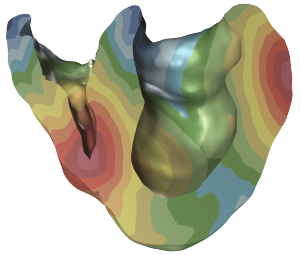links
free download from the publisher
Unfortunately, figures 2-6 in the published paper were printed in greyscale while the captions refer to colour figures. Therefore the original manuscript with colour figures is provided below.
condensed abstract
We simulated myocardial uncoupling with and without disruption of the left bundle branch using a realistic large-scale computer model. Both caused left axis deviation in the ECG but uncoupling reduced amplitude while bundle branch disruption increased it. Their combination can explain a left bundle branch block ECG with low amplitude.
abstract
Aims A left bundle-branch block (LBBB) ECG type may be caused by either a block in the left branch of the ventricular conduction system or by uncoupling in the working myocardium. We used a realistic large-scale computer model to evaluate the effects of uncoupling with and without left-sided block and in combination with biventricular pacing.
Methods and results Action potential propagation was simulated using a reaction-diffusion model of the human ventricles. ECGs and cardiac electrograms were computed from the simulated action potentials by solving the bidomain equations. In all situations, diffuse uncoupling reduced QRS amplitude, prolonged QRS duration, and rotated the QRS axis leftward. Uncoupling by 50% increased QRS duration from 90 to 120 ms with a normal conduction system and from 140 to 190 ms when the left bundle branch was blocked. Biventricular pacing did not change QRS duration but reduced total ventricular activation time.
Conclusion Uncoupling in the working myocardium can mimic left-sided block in the ventricular conduction system and can explain an LBBB ECG pattern with relatively low amplitude. Biventricular pacing improves ventricular activation in true LBBB with or without uncoupling but not in case of 50% uncoupling alone.
Acknowledgements
This work was supported by a grant from the Swiss National supercomputing Centre (CSCS) under project ID 268 and by the project "A High Performance Approach to Cardiac Resynchronization Therapy" within the context of the "Iniziativa Ticino in Rete" and the "Swiss High Performance and Productivity Computing" (HP2C) Initiative. M. Potse was financially supported by a grant from the Fondazione Cardiocentro Ticino.
